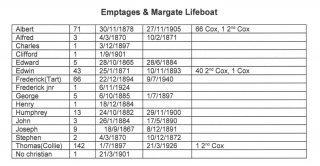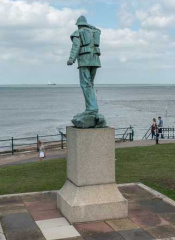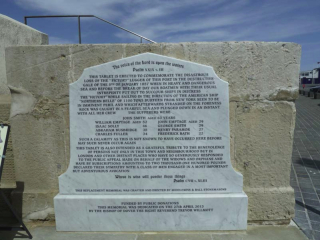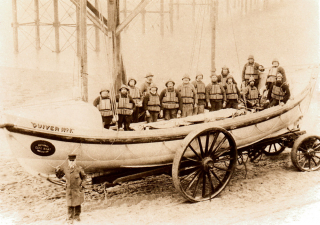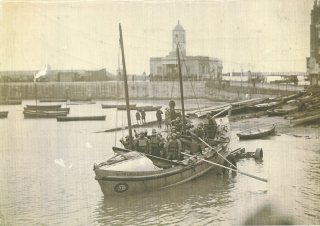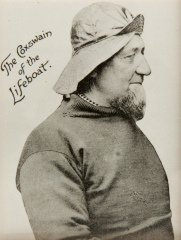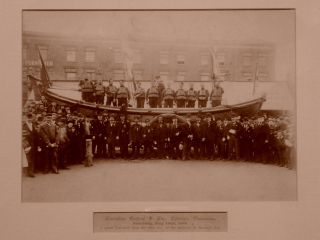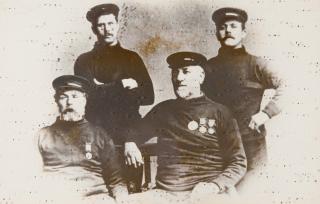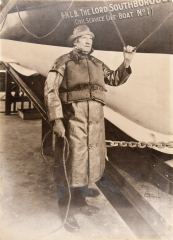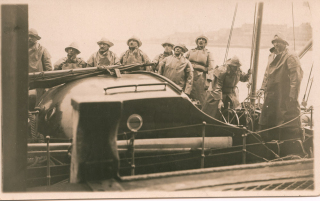On 8th September 2018, as part of the events of the inaugural Gathering of the Emptages and Emtages, we were privileged to have a group meeting at the Margate Lifeboat House.
Nick Smith, Royal National Lifeboat Institution Margate archivist, had combed through the records and extracted the names and dates of Emptages who had served as RNLI Margate lifeboat men.
Evidently I’d be a bad family historian if I didn’t try to identify these lifeboat men, although without any other information, all I can do is look at the dates of service and attempt to match them with individuals. I found several of them already noted as lifeboat men on David Emptage’s Ancestry tree but others for whom a note needs to be added.
And, as per everything we do with the Emptages, I found a few conundrums which I duly emailed to our chief conundrum solver, Pat Johnson and also asked her to check my reasoning regarding the others.
In addition to those named on the RNLI list, I added two more Emptages who had been involved in rescues before the RNLI took over the lifeboat service in 1860.
Nick also provided a list of some notable rescues in which the lifeboat men were involved and I’ve added the rescue in 1857.
The heroism of our lifeboat men through the ages must never be forgotten.
The source for this quote is unknown but it was submitted by a man from Ramsgate so it must have been a Thanet publication:
One day a lady was watching a lifeboat crew about to launch in rough seas to a vessel in distress. Viewing the size of the lifeboat which looked tiny against the huge waves rolling in, she asked of the grizzled old Coxswain, “Surely you don’t have to go out into that“, to which he replied “Yes Lady, we must, but there’s nothing to says we have to come back“.
That must surely encapsulate all that needs to be said about lifeboatmen.”
We know that not all lifeboat men did come back.
Following the loss of the surfboat, Friend to All Nations and its crew of 13 in 1897, a statue of a sailor in thick oilskin and wearing a primitive life belt, shading his eyes whilst looking out to sea, was erected on the sea front at Margate, overlooking Nayland Rock, where the tragedy took place. The names of all the men who lost their lives are carved on the base of the statue.
If you know of any other Emptage lifeboat men, whether during the RNLI’s time or before, please let me know.
Albert John Emptage 1846-1929
Albert John had taken part in several rescues before the coming of the RNLI but most of his service was in the RNLI. A well known boatman, Albert was known as a giant of a man not just because of his height, which was reputed to be 6ft 8inches. He gave trips around the harbour in his pleasure yacht Moss Rose. His life is featured here
1893: When the brigatine Druide of Cardiff was driven ashore on rocks opposite Fore Point, Margate, the lifeboat Quiver made three unsuccessful attempts to reach the ship. Albert John mustered a crew of five to row out to the ship in his yacht’s tiny skiff. Several times the little craft was nearly swamped and overturned but through their hard rowing, constant bailing and great skill, the skiff made its way to the Druide. The crew of five were rescued and the skiff rowed back to shore. Albert John and the other five crew members of the skiff were awarded the Sea Gallantry Medal by the Board of Trade.
1897: On 2nd December, the Persian Empire collided with steamship Carlisle City and was in distress. The surfboat Friend to All Nations was launched and attempted a rescue in hazardous conditions. The conditions were such that the surfboat capsized and nine lifeboatmen perished. One of them was John Benjamin Dike, descended from Henry Emptage and Ann Peal.
The lifeboat Quiver was launched with Coxswain Albert John Emptage at the helm, and through almost impossible odds the men succeeded in rescuing the stricken seamen on the Persian Empire and safely brought them back to shore.
In an article published on 9 August 1905, on stories of seaside heroism, the Evening Express and Evening Mail wrote:
Margate is justly proud of Albert Emptage, the coxswain of the lifeboats, whose well-knit frame is well-known on the jetty. He has been connected with the lifeboat for forty years. Since 1865 he has assisted in the saving of SOME 250 LIVES, and he holds three medals, one from the Board of Trade. He has been out with the boat as long as three days and three nights at a stretch, and thinks nothing of going out to signals from the Galloper Lightship, 32 miles away.”
Alfred Burnett Emptage 1832-1875
Alfred was my great great grandfather, descended from Humphrey Emptage and Catherine Pearce and therefore part of a great sea faring tradition. He was the cousin of Albert John and though from the table above it doesn’t look as though he had been out on as many trips as Albert, these were just the records of service in the RNLI and most of Alfred’s work was before the RNLI took over. His life is featured here.
1857: Alfred and his brothers Charles, Edward and George all took part in the rescue of the crew of the Northern Belle receiving medals for their gallantry.
1871: Alfred and his brother Edward were part of the crew of the lifeboat Quiver when it went to the aid of the crew of the collier brig Sarah. All six men were saved in a rescue which had taken just over three hours including the time for beating out and sailing back to Margate.
Charles Emptage
Conundrum number 1: According to the list, Charles made one lifeboat trip, on 3 December 1897.
It is possible that he was Edwin Charles Emptage 1872-1955, son of Edwin Robert Emptage, see below, but without more information, it is impossible to be sure.
Clifford Herbert Emptage 1865-1931
There seems to have been only one possible candidate: Clifford Herbert, son of Daniel Emptage and Mary Ann Dixon. Both Daniel and his father, also named Daniel, were painters, decorators and glaziers and Clifford became a plumber.
Descended from Henry Emptage and Ann Peal, although there’s no apparent connection with the sea, Clifford’s great grandfather, James Freeman was a mariner, so perhaps it was in his blood.
Edward Joseph Emptage 1842-1886
Edward Joseph was the son of Edward Robert Emptage and Ann Elizabeth Hewett and so was part of the seafaring tradition of Humphrey Emptage and Catherine Pearce. Both father and son were mariners.
During the Crimean war, his half brother, Robert John Emptage, a Royal Navy seaman, was drowned in 1855 when he fell overboard from HMS Leander in Cossack Bay, Balaclava, Sevastopol, Crimean Peninsula.
1880: Edward was one of the crew of the lugger Eclipse when it and the lifeboat Friends to All Nations went to the aid of the crew of the Norwegian barque Farsund which was stranded on the Woolpack Sands during a heavy gale. All the crew of the Farsund were rescued and the Royal Norwegian Home Department awarded the sum of £25 to be shared between the crews of the two rescue boats. There were 17 crew on board the Eclipse, including Edward and his cousin Henry James Dunkin Emptage.
Edwin Robert Emptage 1839-1916
Edwin Robert was the son of William Emptage and his wife Elizabeth Peters. Both Edwin and his father were mariners, descended from the seafaring line of Humphrey Emptage and Catherine Pearce.
William was one of two Emptages who lost their lives when the lugger Victory capsized in the rescue attempt of the crew of the Northern Belle.
1893: Though highly respected, Edwin was made the subject of an enquiry when, in the terrible November gales, as second coxswain, he refused to take the lifeboat out in raging seas to rescue the crew of the brigatine Druide. Some thought he had been made a scapegoat, to give an excuse for political manoeuvring.
Frederick Emptage 1877-1943
Frederick was the son of Albert John Emptage and Anne Warner and so part of Humphrey Emptage and Catherine Pearce’s seafaring dynasty. He was a boatman and continued the lifesaving tradition of the family.
His brother was Petty Office George William Emptage, who lost his life when his ship, HMS Hogue, was sank by a German submarine on 22nd September 1914.
Frederick Emptage jnr
Conundrum number 2 – there are a few Fredericks who could have been a lifeboatman in 1924.
It is possible that he was Frederick Edwin Emptage 1904-1981, son of Edwin Charles, grandson of Edwin Robert Emptage (see above for both). Neither Edwin Charles nor Frederick Edwin earned their living as mariners but both were brought up around boats. Without more information, it’s impossible to be sure.
George Emptage
Conundrum number 3: Unfortunately, both George and George Henry were popular names in the Emptages but, given his dates of service, there are two candidates:
George Henry Emptage, 1849-1911, son of Humphrey John Emptage and Margaret Brown. Both George and Humphrey were mariners.
George Henry Emptage, 1850-1942, son of George Henry Emptage and Susannah Stroud. Father and son were both mariners with George Henry senior being one of the four brothers who took part in the rescue of the crew of the Northern Belle in 1857.
Born one year apart, the two George Henrys were cousins, descended from the seafaring line of Humphrey and Catherine Pearce.
Without more information it is impossible to be sure which George Henry was the lifeboat man.
Henry James Dunkin Emptage 1835-1897
Henry James Dunkin Emptage was the son of Henry Robert Emptage and Elizabeth Dunkin. Both father and son were mariners.
Humphrey John Emptage 1848-1909
Humphrey John was another son of Humphrey and Margaret Brown and brother of George Henry. Father and both sons were mariners.
John Edward Emptage 1859-1941
John was also a popular name amongst the Emptages but the John listed was probably John Edward, son of Joseph Isaiah Emptage and Susannah Harman, descended from Henry Emptage and Ann Peal.
Although John was a carpenter by trade, his father was a mariner and so he would have grown up surrounded by boats.
Joseph Isaiah Emptage 1825-1911
Joseph Isaiah was the son of Henry Emptage, mariner, and Mary Watkins, father of John above, descended from Henry Emptage and Ann Peal.
Joseph lost his parents and three of his siblings to the cholera outbreak in Margate in 1834.
He first went to sea, as an apprentice, in 1841 aged 16 and attained his Merchant Seaman Ticket in 1849.
Stephen John Emptage 1837-1891
Stephen John was a mariner and brother to Edwin Robert, son of William Emptage and Elizabeth Peters.
He joined the Merchant Navy as a boy apprentice in 1850, aged 13 and obtained his seaman’s ticket in 1857.
1870: Stephen and his cousin Alfred were on the same crew roster on the lifeboat Quiver in March when they attempted the rescue of the crew of the stricken ship, Ontario.
Thomas Henry (Collie) Emptage 1876-1929
A mariner, Thomas Henry was the son of John Joy Emptage and Hannah Pound and was descended from Henry Emptage and Ann Peal.
When he was 21 Thomas was injured whilst painting the Margate lifeboat house and had to take time away from his duties as lifeboatman and mariner. He was awarded £150 compensation by the Lifeboat Association.
1900: On 30 January, while a heavy gale was blowing, distress flares were seen from a vessel on the Sands and two lifeboats were launched.
When the lifeboat Eliza Harriet was about a mile from the ship the crew could see that the vessel’s masts had been swept away and that heavy seas were breaking over her. As they got nearer, the vessel broke up and her lights disappeared under the waves.
None of the crew could be seen, and the lifeboat stood by all night in the hope of effecting a rescue, but without success. Coxswain Thomas Henry Emptage, on the return of the Eliza Harriet, after an absence of over twelve hours, reported that no small boat could have lived in such a sea as was running over the Sands, and there was every reason to believe that the whole of the crew, probably 14 or 15 hands, perished.
The vessel was a schooner, and was laden with railway sleepers, many of whom were washed ashore. Neither her name nor nationality was known but she was apparently of Scandinavian ownership.
Thomas’ wife Eliza and mother Hannah (Annie) were killed when a German bomb hit their greengrocer shop in 1917.
William Emptage 1805-1857
William was the son of Henry Emptage and Susannah le Brush, grandson of Humphrey Emptage and Catherine Pearce, so part of the great seafaring tradition. He was the father of Stephen John and Edwin Robert, above.
John Edward Emptage 1828-1857
John Edward was the son of James Emptage and Mary Chatten, nephew of William above, cousin of Alfred, Charles, Edward and George.
1857: When the American sailing ship Northern Belle with 28 crew on board was driven onto rocks, all six Emptages went to the aid of the stricken ship. They were aboard three luggers, Ocean, Victory and Eclipse
The lugger Victory was swamped by the heavy seas and disappeared beneath the waves. Its crew of nine sailors and fishermen, from Margate were drowned, including William and John. The crew of the luggers Ocean and Eclipse were successful in the rescue of the ship’s crew.
There is a memorial to the crew on the arm of Margate harbour, with their names inscribed. And the RNLI Memorial at Poole, Dorset, also carries their names.
The following images and notes were supplied by Nick Smith and are reproduced here by kind permission of Margate RNLI.
1883 Edwin Emptage
Second Quiver No.1 ON265, on foreshore, crew standing inside boat. Man with hand on tiller John James Fox, only known image of this man. Man standing to his left, Second Coxswain Edwin Emptage. Man standing under bow Thomas Jephcott Snr Hon. Sec. 7th man from left, with white beard, Robert Parker. Man stood in bow Henry Thomas Jones. This photograph believed to be to be on the occasion of his taking over as Hon Sec 1893.
1890 Albert Emptage
Crew and surfboat after service to Ville de Calais carried out on 2 March 1890 aground on the Nayland, there was loss of life, RNLI lifeboat did not launch. Photograph taken within a few days. Surfboat Friend to All Nations. LtoR: Albert Emptage, Richard Smith, Samuel Davis, John Dixon, John Sandwell snr, John Dyke, William Campany, William Parker, George Knott, Thomas Campany snr, Henry Brockman, Joseph Knight. Outside harbour wall at base of the High Wall steps.
1895c Albert Emptage
Good photograph of second Quiver No.1 on carriage, on Harbour slipwayy. Seen from promenade. Cox Albert Emptage on tiller. 1893-97.
1898 Albert Emptage
Margate Lifeboat Coxswain 1893-1905.
See A Boatman’s Life
1898 Albert & Thomas Emptage
Lewisham, Catford and Lee Lifeboat Procession, Saturday May 14th 1898. Margate lifeboat crew in boat and the four surfboat survivors standing in front wearing their Quiver medals. Survivors LtoR: Bob Ladd, John Gilbert, Joey Epps, Harry Brockman. In lifeboate LtoR: Albert Emptage, Stephen Clayson, ?, ?, ?, Thomas Emptage, ?, George Reed, ?, ?, ?, ?. Boat ON184 “Joseph Sykes” ex-Upgang.
1906c Albert Emptage
Crew of the Moss Rose 1906. Seated A. Mackie and A. Emptage wearing their lifeboat medals. Standing right, future Coxswain A. Jones
1925 Albert Emptage
Formal portrait Albert Emptage, Coxswain of the Margate Lifeboat 1893-1905. He was 6′ 8″ in height.
1925 Frederick Emptage
B&w postcard showing crew aboard lifeboat The Lord Southborough dressed in oil skins and sou-westers.
5th Sept 1925 – Naming Day
L to R: ?, Dusty Miller, Charlie Epps, Tert Emptage, Ted Jordan, Fred Jones, Bill Mackie, Stephen “Stivvie” Clayson, Rev David Railton (Vicar of Margate)
Notable Services
As it took place before the time of the RNLI, I have added the details of the Northern Belle to Nick’s notes.
5/1/1857 – Northern Belle – Alfred, Charles, Edward and George received medals from the President of the USA together with contributions from the funds raised by the public. William and John lost their lives when the lugger Victory over turned.
25/1/1871 – Sarah and Louise – Alfred and Edwin Emptage, the William Grant first silver medal.
2/3/1890 – Ville de Calais, oil tanker, broke apart, ashore near Nayland, Albert Emptage was aboard the surfboat Friend to All Nations which saved some of the crew.
18/11/1893 Druide The lifeboat took water [so the] Moss Rose skiff [was] taken, Albert Emptage was “Cox” – Board of Trade medal plus one awarded by Rev Benjamin Brigg, local Baptist minister.
3/4/1895 – Humphrey Emptage – 80 mile row to top of Long Sand, Swedish Barque aground Tvedstraved but the crew had left in their own boat.
2/12/1897 – Albert, Frederick and Thomas Emptage all on RNLI lifeboat to Persian Empire when the surfboat Friend to All Nations was lost.
28/4/1919 – Valkyr – Thomas (Collie) Emptage, the Clayson medal.
